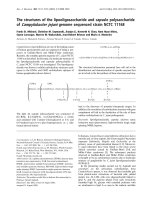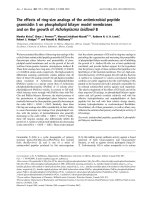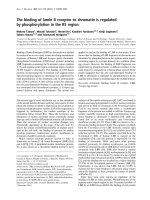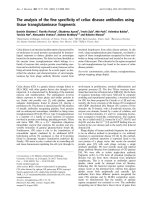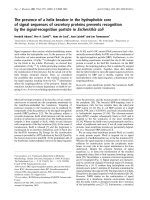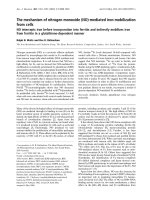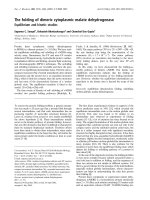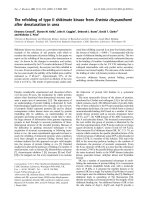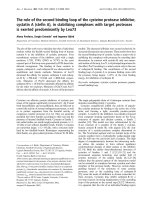Báo cáo y học: " The feasibility of preventing mother-to-child transmission of HIV using peer counselors in Zimbabwe" ppt
Bạn đang xem bản rút gọn của tài liệu. Xem và tải ngay bản đầy đủ của tài liệu tại đây (280.26 KB, 8 trang )
BioMed Central
Page 1 of 8
(page number not for citation purposes)
AIDS Research and Therapy
Open Access
Research
The feasibility of preventing mother-to-child transmission of HIV
using peer counselors in Zimbabwe
Avinash K Shetty*
1
, Caroline Marangwanda
2
, Lynda Stranix-Chibanda
3,4
,
Winfreda Chandisarewa
2
, Elizabeth Chirapa
2
, Agnes Mahomva
5
,
Anna Miller
6
, Micah Simoyi
7
and Yvonne Maldonado
8
Address:
1
Department of Pediatrics, Wake Forest University Health Sciences, Winston-Salem, USA,
2
Zimbabwe AIDS Prevention Project-University
of Zimbabwe, Harare, Zimbabwe,
3
Department of Pediatrics, University of Zimbabwe School of Medicine, Harare, Zimbabwe,
4
University of
Zimbabwe-University of California San Francisco Collaborative Program in Women's Health, Harare, Zimbabwe,
5
Ministry of Health and Child
Welfare, Harare, Zimbabwe,
6
Elizabeth Glaser Pediatric AIDS Foundation, Harare, Zimbabwe,
7
Chitungwiza Health Department, Chitungwiza,
Zimbabwe and
8
Department of Pediatrics, Stanford University School of Medicine, Palo Alto, USA
Email: Avinash K Shetty* - ; Caroline Marangwanda - ; Lynda Stranix-Chibanda - lynda@uz-
ucsf.co.zw; Winfreda Chandisarewa - ; Elizabeth Chirapa - ;
Agnes Mahomva - ; Anna Miller - ; Micah Simoyi - ;
Yvonne Maldonado -
* Corresponding author
Abstract
Background: Prevention of mother-to-child transmission of HIV (PMTCT) is a major public health
challenge in Zimbabwe.
Methods: Using trained peer counselors, a nevirapine (NVP)-based PMTCT program was
implemented as part of routine care in urban antenatal clinics.
Results: Between October 2002 and December 2004, a total of 19,279 women presented for
antenatal care. Of these, 18,817 (98%) underwent pre-test counseling; 10,513 (56%) accepted HIV
testing, of whom 1986 (19%) were HIV-infected. Overall, 9696 (92%) of women collected results
and received individual post-test counseling. Only 288 men opted for HIV testing. Of the 1807 HIV-
infected women who received posttest counseling, 1387 (77%) collected NVP tablet and 727 (40%)
delivered at the clinics. Of the 1986 HIV-infected women, 691 (35%) received NVPsd at onset of
labor, and 615 (31%) infants received NVPsd. Of the 727 HIV-infected women who delivered in the
clinics, only 396 women returned to the clinic with their infants for the 6-week follow-up visit; of
these mothers, 258 (59%) joined support groups and 234 (53%) opted for contraception. By the
end of the study period, 209 (53%) of mother-infant pairs (n = 396) came to the clinic for at least
3 follow-up visits.
Conclusion: Despite considerable challenges and limited resources, it was feasible to implement
a PMTCT program using peer counselors in urban clinics in Zimbabwe.
Published: 1 August 2008
AIDS Research and Therapy 2008, 5:17 doi:10.1186/1742-6405-5-17
Received: 7 August 2007
Accepted: 1 August 2008
This article is available from: />© 2008 Shetty et al; licensee BioMed Central Ltd.
This is an Open Access article distributed under the terms of the Creative Commons Attribution License ( />),
which permits unrestricted use, distribution, and reproduction in any medium, provided the original work is properly cited.
AIDS Research and Therapy 2008, 5:17 />Page 2 of 8
(page number not for citation purposes)
Background
Zimbabwe, a Southern African country with a population
of approximately 12 million people, has one of the high-
est HIV prevalence rates in the world [1]. In 2003, an esti-
mated 1.8 million individuals were living with HIV/AIDS
in Zimbabwe, over half of whom were women [2]. Pri-
mary HIV infection in women of reproductive age fuels
the perinatal HIV epidemic. Recent estimates indicate that
23.4% of pregnant women attending antenatal clinics in
Zimbabwe are HIV seropositive [1]. Without any interven-
tion, an estimated 50,000 infants acquire infection from
their mothers annually in Zimbabwe [3]. In recent years,
several clinical trials have demonstrated the efficacy of
simpler and less expensive short regimens of zidovudine
(ZDV), single-dose nevirapine (NVPsd), ZDV/lamivudine
(3TC) or ZDV/NVPsd in preventing mother to child HIV
transmission (PMTCT) in sub Saharan Africa [4-7]. How-
ever, implementation of PMTCT interventions on a large
scale in resource-limited settings remains a formidable
challenge [8-14].
In 1998, the Zimbabwe AIDS Prevention Project (ZAPP)
was the first site in the country to successfully implement
a pilot PMTCT project using community volunteers in
Chitungwiza, a high density periurban community with a
population of 1.5 million [15]. Routine antenatal services
in Chitungwiza are provided by 4 municipal clinics,
where approximately 10,000 deliveries occur annually. In
Zimbabwe, 99% of women breastfeed and formula feed-
ing is not feasible, or affordable or culturally acceptable in
most settings. In 2000, the Zimbabwe Ministry of Health
and Child Welfare (MOHCW) established national policy
guidelines and implementation plan for PMTCT [16]. In
2002, with funding from the Elizabeth Glaser Pediatric
AIDS Foundation, the ZAPP-Call-to Action (CTA) project
collaborated with the MOHCW and Chitungwiza Health
Department (CHD) to implement a NVP-based PMTCT
program in Chitungwiza. The present report describes our
experience in integrating a PMTCT program into routine
prenatal care in urban Zimbabwe, highlighting the opera-
tional challenges and lessons learnt during implementa-
tion.
Methods
PMTCT program components
The components of the CHD-ZAPP-CTA PMTCT program
are summarized in Table 1. The ZAPP-CTA project and
clinic staff consisted of project coordinator, counseling
coordinator, project physician, nurses and peer coun-
selors. The PMTCT program was integrated into the exist-
ing antenatal care at the 4 clinics.
Selection of peer counselors and counseling duties
HIV-infected women who had had previously partici-
pated in a PMTCT program at our site, currently enrolled
in support groups, and had disclosed their positive HIV
status to partner or family member were selected to
become peer counselors. A total of 24 peer counselors
were employed by ZAPP, worked full time and paid a sal-
ary.
The counselors were divided into three groups to work at
each of the 4 clinics. One group of counselors were
assigned to the clinics (n = 8; 2 per clinic) for delivering
health education talks (2 days per week) to antenatal
women; the second group (n = 8; 2 per clinic) focussed on
providing psychosocial support and counsel mothers on
disclosure and infant feeding (2 days per week), and facil-
itate mother-infant follow-up (1 day per week), and the
third group (n = 8) were assigned to conduct community
mobilization activities on PMTCT.
Training of peer counselors
Before implementation, staff at the 4 clinic sites attended
an intensive 2-week training workshop on voluntary
counseling and HIV testing (VCT) and PMTCT. The train-
ing curriculum was based on WHO training modules and
included general HIV/AIDS facts, systematic counseling
approach, and practical counseling techniques using
scripts and role-play, and risk of transmission [17].
All peer counselors were given additional training on
infant feeding counseling by MOHCW nutritional depart-
ment staff with a focus on safe breastfeeding practices and
exclusive breastfeeding for 6 months. Other training
workshops included bereavement counseling, psychoso-
Table 1: Basic package for Prevention of Mother-to-Child HIV Transmission.
1. Training of healthcare workers on PMTCT
2. VCT for all pregnant women using rapid HIV testing
3. Administration of NVPsd, based on the HIVNET 012 regimen [5]
4. Counseling and support on infant feeding choices according to WHO guidelines [19]
5. Establishment of community-based psychosocial support groups
6. Mother-infant follow-up until 18 months after delivery (with rapid testing of infant at 18 months of age after family consent)
7. Provision of CTX prophylaxis to symptomatic mothers and all HIV-exposed infants from 6 weeks of age until 18 months of age
8. Community mobilization, information, education, and communication activities
Abbreviations: CTX, Cotrimoxazole; NVPsd, single-dose nevirapine; PMTCT, Prevention of Mother-to-Child HIV Transmission; VCT, Voluntary
counseling and HIV testing; WHO, World Health Organization;
AIDS Research and Therapy 2008, 5:17 />Page 3 of 8
(page number not for citation purposes)
cial support and facilitation of support groups. In addi-
tion, CDC-Zimbabwe trained laboratory personnel on
rapid HIV testing.
The peer counselors met weekly to discuss their experi-
ences and receive feedback from their supervisor. Their
performance was evaluated two times during the study
period by the project coordinator and counseling coordi-
nator. Every month, the ZAPP-CTA project team held a
PMTCT coordination meeting with active participation
from the CHD, research-based clinic staff, and other stake
holders to discuss experiences and challenges during pro-
gram implementation, and improve quality of services.
Voluntary counseling and HIV testing (VCT) procedures
The target population consisted of pregnant women pre-
senting for antenatal care at the 4 clinics. The peer coun-
selors under the supervision of clinic nurses held 15-
minute group education and discussion sessions with
pregnant women in the ANC waiting area, using a flip
chart as a discussion guide. The discussion focused on HIV
transmission, PMTCT, antiretroviral prophylaxis with
sdNVP, and VCT for all mothers. Women who arrived for
prenatal care when no group could be convened received
the same education individually via pre-test counseling.
In addition to routine prenatal care (provision of iron and
multivitamins, screening and treatment of sexually trans-
mitted infections), VCT was offered to all pregnant
women. During this study period, an "opt-in" approach
or client-initiated testing was in place, wherein HIV test-
ing was conducted after individual pre-test counseling by
trained peer counselors, with clients actively choosing
whether to be tested.
Maternal HIV status was determined on site using two
rapid tests in parallel (Capillus Test, Cambridge Diagnos-
tics Ireland Limited, Galway, Ireland and Dipstick Test,
Immuno Chemical Laboratory, Bangkok, Thailand) on
each blood sample, and a third test (Determine Test, HV
laboratories Abbott Park, IL, USA) as a tie breaker. HIV
test results were offered to clients the same day, but
women could choose to wait for the results or to come
back at any other time.
Women who collected their test results received extensive
individual post-test counseling, with a focus on PMTCT
interventions (e.g., sdNVP prophylaxis) and psychosocial
support for women who were identified as HIV-infected.
Counseled women were encouraged to bring their part-
ners for free VCT at the clinics. Confidentiality was main-
tained at all pre-and post-test counseling sessions by
designating individual rooms for counseling.
Single-dose nevirapine prophylaxis regimen
A single NVP 200 mg tablet was provided to each HIV-
infected woman (at ≥ 28 weeks of gestation) with instruc-
tions to swallow the tablet at the onset of labor, and return
to the clinic for delivery. HIV-exposed babies were admin-
istered NVPsd (2 mg/kg) within the first 72 h of life [5]. If
the mother took NVP less than 2 h before delivery or did
not take NVP at onset of labor, the HIV-exposed infant
received 2 doses of NVP, one dose immediately after birth
and the second dose at discharge [18].
Infant feeding counseling
Based on their serostatus, women were counseled on
infant feeding choices reviewing the risks and benefits of
replacement, mixed and exclusive breastfeeding according
to WHO and national guidelines [16,19]. Mothers who
are symptomatic and unable to breastfed, were provided
free formula acquired from funding through Save the
Children Norway-Zimbabwe.
Establishment of support groups
At the post-test counseling session, HIV-infected mothers
were referred to psychosocial support (PSS) groups. In
addition, newly diagnosed HIV-infected mothers were
paired with a clinic-based peer counselor, who acted as
"mentor mothers" and provided psychosocial support
during pregnancy, delivery and postnatal period, and
cope with complex issues related to disclosure, infant
feeding, compliance with NVP and co-trimoxazole proph-
ylaxis, and ensuring follow-up. The PSS groups meet once
a month at the clinic, and the sessions facilitated by the
peer counselors.
Mother-infant follow-up and care
Mothers and infants were followed at the clinics from 6
weeks postpartum until 18 months for infant growth
monitoring, and assessing maternal health. The peer
counselors met with mother/infant pairs on a monthly
basis in the clinic. Symptomatic mothers and infants were
referred to the clinic physician. Infant follow-up visits
were incorporated within MCH services, coinciding with
routine immunization visits. Co-trimoxazole prophylaxis
to prevent Pneumocystis carinii pneumonia (PCP) was pro-
vided to all symptomatic HIV-infected mothers (WHO
clinical stage III and stage IV disease). Co-trimoxazole
prophylaxis was also administered to all HIV-exposed
infants starting at 6 weeks of age and continued until 18
months of age. CTX compliance was monitored by peer
counselors. Infant HIV diagnosis at 18 months of age was
determined by rapid testing after obtaining family con-
sent.
Community mobilization activities
In order to raise awareness about HIV/AIDS, reduce
stigma and discrimination, and inform the public about
AIDS Research and Therapy 2008, 5:17 />Page 4 of 8
(page number not for citation purposes)
the availability of PMTCT interventions at the clinics,
community education activities were conducted through
information sessions and group meetings using locally
developed IEC education materials. In addition to the
clinic-based staff, a group of 10 peer counselors (4 males,
6 females) were trained in community mobilization on
PMTCT through the use of drama, with periodic refresher
courses once every 6 months. The ZAPP-CTA drama-
group performed daily in a rotating basis at different ven-
ues in Chitungwiza such as bus terminals, shopping cent-
ers, market places, high schools, colleges and churches.
Monthly meetings between the clinic staff and the Com-
munity Advisory Board (CAB) also ensured feedback and
continued support for the PMTCT program.
Program monitoring
PMTCT program data regarding counseling and accept-
ance of HIV testing, antiretroviral interventions for
mother/infant, and follow-up were collected according to
national PMTCT monitoring and evaluation tools. Data
were entered into a computerized database. Pre-existing
monitoring tools such as antenatal and delivery log books
were used as needed to monitor program uptake.
Ethical review
The Call-to-Action project was approved by the Institu-
tional Review Boards at Stanford University and Wake
Forest University Health Sciences, and the ethics commit-
tee at the Chitungwiza Health Department.
Results
Voluntary counseling and HIV testing
Between October 2002 through December 2004, 19, 279
pregnant women presenting for their first antenatal care
visit and received health education. Of these, 18,817
(98%) underwent individual pre-test counseling for HIV;
10,513 (56%) accepted HIV testing, of whom 1986 (19%)
were found to be HIV-infected. Overall, 9696 (92%) of
women collected their test results and underwent individ-
ual post-test counseling (Table 2). Of the 9696 post-test
counseled women who were encouraged to bring their
partners for free VCT during pre-test counseling, only 288
men opted for HIV testing; 198 returned to collect their
results and post-test counseling, and of these, 84 were
HIV-infected.
PMTCT interventions among HIV-infected women
Of the 1807 HIV-infected women who received posttest
counseling, 1387 (77%) collected NVP tablet to take
home, of whom only 727 (40%) delivered at one of the 4
antenatal clinics. The rest were referred to the local hospi-
tal for complicated pregnancies, delivered at another
health care facility or at home. Of the 1986 HIV-infected
women, 691 (35%) received NVPsd tablet at onset of
labor, and 615 (31%) infants received NVPsd syrup
within the first 3 days of life. (Table 3).
Care for HIV-infected mothers and HIV-exposed infants
Of the 727 HIV-infected women who delivered in the clin-
ics, only 396 women/infants returned to the clinic for the
6-week follow-up visit. Of these mothers (n = 396), 258
(59%) joined psychosocial support groups and 234
(53%) opted for contraception (Table 4). Symptomatic
disease (WHO clinical stage III/IV) was noted in 64 (16%)
women. By the end of the study period, 209 (53%) of
mother-infant pairs (n = 396) came to the clinic for at
least 3 follow-up visits. In our study, 97% of women
opted for exclusive breastfeeding in the first 6 months of
life.
Discussion
This report demonstrates the feasibility of implementing
a NVP-based PMTCT program using peer counselors in a
periurban antenatal clinic setting in Zimbabwe. The peer
counselors were HIV-infected women who had previously
participated in a ZDV-based PMTCT program at our site.
In this country, economic hardships and political instabil-
ity have seriously undermined the maternal and child
health services [20]. Despite the high nursing staff attri-
tion rate, severe shortage of human resources staff, and
weak health care system at our clinics, PMTCT services
delivered by peer counselors were feasible, acceptable and
sustainable.
In addition to providing health education and HIV coun-
seling, the peer counselors acted as "mentors" to newly
diagnosed HIV-infected mothers providing ongoing
counseling and support, which involved several complex
issues such as coping, bereavement, domestic abuse,
spousal abandonment, discordant test results, family
planning, and negotiating safe sex. The counselors also
provided infant feeding counseling, referred clients for
psychosocial support, facilitated support group meetings,
and followed mothers and infants from birth through 18
months in the clinics.
Table 2: Acceptance of voluntary counseling and HIV testing
among pregnant women in Zimbabwe
Indicator Number (%)
Total women starting antenatal care 19279
Women receiving group health education 19279 (100)
Pre-test counseled (n = 19279) 18817 (98)
Women accepted HIV testing (n = 18817) 10513 (56)
Women HIV-infected (n = 10513) 1986 (19)
Post-test counseled (n = 10513) 9696 (92)
Partners HIV tested 288
Partners post-test counseled (n = 288) 198
Partners HIV-infected (n = 198) 84
AIDS Research and Therapy 2008, 5:17 />Page 5 of 8
(page number not for citation purposes)
A close working relationship between the project staff, the
municipality staff from the Chitungwiza health depart-
ment, and the ministry of health and child welfare of Zim-
babwe ensured smooth functioning of the program. Our
findings are important for policy makers because the
incorporation of peer counselors in PMTCT program
could be replicated in other resource-limited settings.
Delivery of PMTCT services using trained peer counselors
is now routinely implemented at several urban and rural
sites in Zimbabwe [1,12]. Adequate staffing and on-site
training is critical to maintain the high quality of coun-
seling services [12].
The prevalence of HIV infection in Zimbabwe is one of the
highest in the world. In the present study, 19% of women
were HIV-infected; this finding is consistent with recent
trends in HIV prevalence in Zimbabwe [1]. During the
study period, antenatal HIV testing was routinely per-
formed after individual pre-test counseling, with clients
actively choosing whether to be tested (i.e., an "opt-in"
approach or client-initiated testing). It is concerning that
only 56% of pregnant women at our site opted for HIV
testing. Qualitative data from focus group discussions
among antenatal women have revealed a number of bar-
riers to VCT. Reasons most often cited by women in our
clinics who refuse testing include the need to consult their
husbands/partners, fear of stigma and domestic violence
upon disclosure to partner, lack of availability of highly
active antiretroviral therapy (HAART), and denial of HIV
[21]. These social and health service barriers have been
identified in other settings [22,23]. Therefore, new inno-
vative approaches to antenatal HIV testing should be con-
sidered.
Provider-initiated routine HIV testing (i.e., an "opt-out"
approach) is currently the standard of care for pregnant
women in resource-rich nations [24]. Recently, successful
introduction of routine opt-out antenatal HIV testing has
been reported from Botswana and Kenya. [25-27]. A
recent survey conducted in two rural districts of Zimba-
bwe found that routine antenatal HIV testing is acceptable
to pregnant women [28]. A pilot project at our urban
PMTCT site evaluated the feasibility, acceptability, and
impact of routine offer of antenatal (opt-out approach)
HIV testing in 2005. Routine antenatal HIV testing
resulted in significant increases in testing and PMTCT
services without measurable adverse consequences [29].
Low return rate for HIV-positive test results has been a
major problem in many PMTCT programs in sub Saharan
Africa [9,13,14]. In our study, the rate of collection of pos-
itive test results among women was 92%. Use of rapid on-
site HIV testing with same-day availability of test results
may partly explain the high return rates. Similar findings
have been reported in other PMTCT programs in sub
Saharan Africa [30,31].
In this study, the overall maternal/infant uptake of NVPsd
was poor because of the mobile population and loss to
follow-up at each stage of the PMTCT cascade of services.
Dispensing NVPsd to HIV-infected pregnant mothers at
the time of diagnosis may improve access to antiretroviral
prophylaxis in our setting. The high uptake of NVPsd
among the documented HIV-positive deliveries in the
clinics is encouraging. However, it is important to note
that the HIV-infected mothers who delivered in our clinics
represent a highly selected group with different health
seeking behaviors from those women who delivered else-
where.
Table 3: Acceptance of PMTCT interventions among HIV-infected women
HIV-infected mothers Number (%)
Received test results and post-test counseled (n = 1986) 1807 (91%)
Women prescribed NVPsd (n = 1807) 1387 (77%)
Women known to have delivered at the clinics (n = 1807) 727 (40%)
Mothers who took NVPsd tablet during labor (n = 1986) 691 (35%)
Infants who received NVPsd (n = 1986) 615 (31%)
Abbreviations: NVPsd, single-dose nevirapine; PMTCT, Prevention of Mother-to-Child HIV Transmission; VCT, Voluntary counseling and HIV
testing;
Table 4: Care for HIV-infected mothers and HIV-exposed infants
(n = 396)
Indicator Number (%)
Median age of mothers 26 years
Married 326 (82%)
Joined psychosocial support group 258 (65%)
Hormonal contraception and condom use 234 (59%)
Maternal-child follow-up (at least 3 visits) 209 (53%)
HIV-infected women* on CTX prophylaxis 64 (16%)
HIV-exposed infants on CTX prophylaxis 285 (72%)
HIV-infected women currently receiving ARV 1
Maternal Deaths 12
Abbreviations: HAART, highly active antiretroviral therapy; CTX,
co-trimoxazole
*WHO Stage III & IV disease
AIDS Research and Therapy 2008, 5:17 />Page 6 of 8
(page number not for citation purposes)
In our study, the proportion of male partners accepting
HIV testing was very low. This finding is not surprising
because none of the PMTCT interventions targeted men
specifically. Low participation of male partners has been
reported in rural PMTCT program as well [12]. Male part-
ner involvement in conjunction with enhanced commu-
nity mobilization and IEC activities geared towards HIV
prevention, non discrimination and non stigmatization
may improve VCT uptake and PMTCT interventions [32].
Innovative approaches to promote male involvement are
urgently needed. HIV-infected women often don't dis-
close their serostatus to their husbands/partners due to
fear of stigma, violence, abandonment or divorce [33,34].
A recent report from Zambia showed that antenatal cou-
ple VCT did not increase the risk of adverse social events
associated with HIV disclosure [35]. Another report from
Kenya showed that antenatal couple counseling increased
uptake of sdNVP and formula feeding [36]. Strategies to
enhance antenatal VCT coverage and uptake of PMTCT
interventions through gender-sensitive programs should
be developed.
Psychosocial support with special attention to disclosure
issues is a critical component of PMTCT program. Two-
thirds of HIV-infected women in our program joined sup-
port groups. Experiences on PSS from urban and rural
PMTCT programs in Zimbabwe have led to development
of national PSS guidelines which will be disseminated to
health care workers throughout the country for wide-
spread implementation.
In the present study, 59% HIV-infected women opted for
contraceptive options in the postpartum period. Integrat-
ing family planning with PMTCT programs is crucial in
sub Saharan Africa, where HIV seroprevalence and rates of
unintended pregnancy are high [37].
In our program, the sdNVP regimen was used to prevent
perinatal HIV transmission. Data from African trials indi-
cate that addition of maternal intrapartum/neonatal
sdNVP to short-course ZDV or ZDV-3TC may reduce peri-
natal HIV transmission rate to below 5%, approximately
half the transmission rate that can be achieved by sdNVP
[7,38]. Pilot projects supported by donor funds has been
implemented in Zimbabwe to evaluate the field accepta-
bility and effectiveness of more efficacious antiretroviral
regimens in PMTCT programs, in line with World Health
Organization (WHO) guidelines [39]. Finally, despite
effective PMTCT interventions, ongoing breastfeeding
HIV transmission is a major public health issue [40].
Early diagnosis of HIV infection in exposed infants is crit-
ical to improve pediatric HIV/AIDS care in resource-lim-
ited countries [41]. However, the high cost of PCR testing,
technical expertise needed for infant venesection, and
other logistic issues have posed major obstacles at our site.
Therefore, developing alternative low-cost laboratory
methods for early infant HIV diagnosis remains a priority
for Zimbabwe and other resource-poor settings. A pro-
spective cohort study from South Africa has shown that
HIV DNA PCR tests performed on dried blood spots from
HIV-exposed infants at 6 weeks of age yields accurate
results [42]. Another report from Zimbabwe suggests that
the ultrasensitive p24 antigen assay is a useful diagnostic
test for diagnosing HIV infection among infants less than
2 years with similar sensitivity and specificity as HIV RNA
PCR [43].
Follow-up of HIV-exposed infants poses a tremendous
challenge in resource-limited settings. Maternal/infant
follow-up should be integrated within the existing MCH
services. To address this challenge, a decentralized district
approach is suggested in rural settings [12]. In addition,
the child heath card has been recently revised by the
MOH/CW with support from EGPAF and Centers for Dis-
ease Control and Prevention (CDC)-Zimbabwe to facili-
tate mother-infant follow-up at all antenatal clinics in
Zimbabwe.
Antenatal clinics are a key entry point into HIV treatment
and care, together with interventions to reduce mother-to-
child transmission of HIV. In our program, 16% of HIV-
infected women had evidence of WHO clinical stage III
and IV disease. Access to HAART was limited at the time
of the study. Strategies to scale up treatment access are
urgently required in resource-limited settings to prevent
mortality as well as transmission [44]. Recent reports from
South Africa and Zambia showed that it is feasible to inte-
grate HAART within antenatal care [45].
The current report has several limitations. First, the
extremely mobile population in our urban setting, loss to
follow up of HIV-infected women after the post-test coun-
seling visit and subsequently during the postnatal period,
and unavailability of early infant diagnosis makes it
impossible to measure the precise coverage and impact of
sdNVP intervention. Second, this is not a controlled
study. Finally, the quantitative data presented from a large
urban setting, which poses different challenges compared
to similar PMTCT programs in rural settings.
Despite the severe shortage of human and economic
resources encountered in our setting, it was feasible to
implement a PMTCT program using peer counselors in
urban Zimbabwe. Strong commitment from the Ministry
of Health and the Chitungwiza Health Department, and
financial and technical support from EGPAF and CDC-
Zimbabwe contributed significantly to the success of the
program.
AIDS Research and Therapy 2008, 5:17 />Page 7 of 8
(page number not for citation purposes)
Competing interests
The authors declare that they have no competing interests.
Authors' contributions
AS participated in the design, supervised study implemen-
tation and drafted the manuscript. CM, LS, WC, EC, and
MS participated in study implementation and data collec-
tion. AM and AM participated in study design and pro-
vided technical expertise. YM conceived the study, and
participated in its design and coordination. All authors
read and approved the final manuscript.
Acknowledgements
This project was funded by Elizabeth Glaser Pediatric AIDS Foundation
(EGPAF) and United States Agency for International Development
(USAID). The authors wish to thank the Zimbabwe Ministry of Health and
Child Welfare and Chitungwiza Health Department, Elizabeth Glaser Pedi-
atric AIDS Foundation administrative and technical staff including Maurice
Adams, Patricia Mbetu, Jo Keatinge, Matthews Maruva, Chuck Hoblitzelle,
Jack Forbes and Catherine Wilfert, Family AIDS Initiatives Program Part-
ners, ISPED and Kapnek Trust, Prof. Godfrey Woelk, Dr. Margaret
Maulana, Lisa Langhaug, Elizabeth Mbizvo, Mary Bassett, Godfrey Woelk,
Darlington Chimwara, Sostain Moyo, Jennifer Wells, David Hill, Edward
Matsikire, UZ-UCSF Collaborative Program in Women's Health (Tsungai
Chipato, Rose Kambarami), Departments of Pediatrics, Community Medi-
cine and Obstetrics and Gynecology, University of Zimbabwe School of
Medicine, PMTCT Partnership Forum, CDC-Zimbabwe, Zimbabwe AIDS
Prevention Project nurses, peer counselors, and all the mothers and infants
who participated in the study.
References
1. Mahomva A, Greby S, Dube S, Mugurungi O, Hargrove J, Rosen D,
Dehne KL, Gregson S, St Louis M, Hader S: HIV prevalence and
trends from data in Zimbabwe, 1997–2004. Sex Transm Inf
2006, 82(Suppl 1):42-47.
2. Zimbabwe Ministry of Health: Zimbabwe national HIV and AIDS
estimates, 2003. Ministry of Health; Harare, Zimbabwe 2003.
3. United Nations Program on HIV/AIDS (UNAIDS): Epidemiological fact
sheets on HIV/AIDS and sexually transmitted infections, Zimbabwe
UNAIDS, Geneva, Switzerland; 2002.
4. Leroy V, Karon JM, Alioum A, Ekpini ER, Meda N, Greenberg AE,
Msellati P, Hudgens M, Dabis F, Wiktor SZ, the West Africa PMTCT
Study Group: 24-month efficacy of a maternal short-course
zidovudine regimen to prevent mother-to-child transmis-
sion of HIV-1 in West Africa. AIDS 2002, 16:631-641.
5. Jackson JB, Musoke P, Fleming T, Guay LA, Bagenda D, Allen M, Nak-
abiito C, Sherman J, Bakaki P, Owor M, Ducar C, Deseyve M, Mwatha
A, Emel L, Duefield C, Mirochnick M, Fowler MG, Mofenson L, Miotti
P, Gigliotti M, Bray D, Mmiro F: Intrapartum and neonatal single-
dose nevirapine compared with zidovudine for prevention of
mother-to-child transmission of HIV-1 Kampala, Uganda: 18
month follow-up of the HIVNET 012 randomized trial. Lancet
2003, 362:859-868.
6. PETRA Study Team: Efficacy of three short-course regimens of
zidovudine and lamivudine in preventing early and late
transmission of HIV-1 from mother to child in Tanzania,
South Africa, and Uganda (Petra Study): a randomized, dou-
ble-blind, placebo-controlled trial. Lancet 2002, 359:1178-1186.
7. Dabis F, Bequet L, Ekouevi DK, Viho I, Rouet F, Horo A, Sakarovitch
C, Becquet R, Fassinou P, Dequae-Merchadou L, Welffens-Ekra C,
Rouzioux C, Leroy V, ANRS 1201/1202 DITRAME PLUS Study
Group: Field efficacy of zidovudine, lamivudine and single-
dose nevirapine to prevent peripartum HIV transmission.
AIDS 2005, 19:309-318.
8. Dabis F, Ekpini ER: HIV-1/AIDS and maternal and child health
in Africa. Lancet 2002, 359:2097-2104.
9. Msellati P, Hingst G, Kaba F, Viho I, Welffens-Ekra C, Dabis F: Oper-
ational issues in preventing mother-to-child transmission of
HIV-1 in Abidjan, Cote d'Ivoire, 1998–99. Bull World Health
Organ 2001, 79:641-647.
10. Meda N, Leroy V, Viho I, Msellati P, Yaro S, Mandelbrot L, Montcho
C, Manigart O, Dabis F, DITRAME-ANRS 049 Study Group: Field
acceptability and effectiveness of the routine utilization of
zidovudine to reduce mother-to-child transmission of HIV-1
in West Africa.
AIDS 2002, 16:2323-2328.
11. Welty TK, Bulterys M, Welty ER, Tih PM, Ndikintum G, Nkuoh G,
Nkfusai J, Kayita J, Nkengasong JN, Wilfert CM: Integrating pre-
vention of mother-to-child HIV transmission into routine
antenatal care: the key to program expansion in Cameroon.
J Acquir Immune Defic Syndr 2005, 40:486-493.
12. Perez F, Mukotekwa T, Miller A, Orne-Gliemann J, Glenshaw M, Chit-
sike I, Dabis F: Implementing a rural programme of prevention
of mother-to-child transmission of HIV in Zimbabwe: first 18
months of experience. Trop Med Int Health 2004, 9:774-783.
13. Stringer EM, Sinkala M, Stringer JS, Mzyece E, Makuka I, Goldenberg
RL, Kwape P, Chilufya M, Vermund SH: Prevention of mother-to-
child transmission of HIV in Africa: successes and challenges
in scaling-up a nevirapine-based program in Lusaka, Zambia.
AIDS 2003, 17:1377-1382.
14. Temmerman M, Quaghebeur A, Mwanyumba F, Mandaliya K:
Mother-to-child HIV transmission in resource poor settings:
how to improve coverage? AIDS 2003, 17:1239-1242.
15. Shetty AK, Moyo M, Mhazo M, von Lieven A, Mateta P, Katzenstein
DA, Maldonado Y, Hill D, Bassett MT: The feasibility of voluntary
counseling and HIV testing for pregnant women using com-
munity volunteers in Zimbabwe. Int J STD AIDS 2005,
16:755-759.
16. Zimbabwe Ministry of Health and Child Welfare: Infant feeding and
HIV/AIDS guidelines for health workers in Zimbabwe. Minis-
try of Health Nutrition Unit, Harare, Zimbabwe 2002.
17. UNAIDS, UNICEF and WHO: Local monitoring and evaluation of the
integrated prevention of mother to child HIV transmission in low-income
countries UNAIDS, Geneva, Switzerland; 2000.
18. Mirochnick M, Dorenbaum A, Blanchard S, Cunningham CK, Gelber
RD, Mofenson L, Culnane M, Sullivan JL: Predose infant nevirapine
concentration with the two-dose intrapartum neonatal nev-
irapine regimen: association with timing of maternal intra-
partum nevirapine dose. J Acquir Immune Defic Syndr 2003,
33:153-156.
19. WHO/UNAIDS/UNICEF: HIV and infant feeding counselling course
World Health Organization, Geneva, Switzerland; 2000.
20. de Castella T: Health workers struggle to provide care in Zim-
babwe. Brain drain adds to woes of a cash-strapped health-
care system. Lancet 2003, 362:46-47.
21. Moyo S, Shetty AK, Maldonado T, Mhazo M, Katzenstein D, Bassett
MT:
Experience and concerns of HIV-infected women
enrolled in MTCT program in Zimbabwe. Proceedings of the XIV
International AIDS Conference: 7–12 July 2002; Barcelona. Spain .
(Abstract # TuPeE5198)
22. Maman S, Mbwambo J, Hogan NM, Kilonzo GP, Sweat M: Women's
barriers to HIV-1 testing and disclosure: challenges for HIV-
1 voluntary counselling and testing. AIDS Care 2001,
13:595-603.
23. Vermund SH, Wilson CM: Barriers to HIV testing – where next?
Lancet 2002, 360:1186-1187.
24. Centers for Disease Control and Prevention (CDC): Revised rec-
ommendations for HIV screening of pregnant women.
MMWR 2001, 50:59-86.
25. Centers for Disease Control and Prevention (CDC): Introduction
of routine HIV testing in prenatal care – Botswana, 2004.
MMWR 2004, 53:1083-1086.
26. van't Hoog AH, Mbori-Ngacha DA, Marum LH, Otieno JA, Misore
AO, Nganga LW, Decock KM: Preventing mother-to-child
transmission of HIV in Western Kenya: operational issues. J
Acquir Immune Defic Syndr 2005, 40:344-349.
27. Creek TL, Ntumy R, Seipone K, Smith M, Mogodi M, Smit M, Legwaila
K, Molokwane I, Tebele G, Mazhani L, Shaffer N, Kilmarx PH: Suc-
cessful introduction of routine opt-out HIV testing in antena-
tal care in Botswana. J Acquir Immune Defic Syndr 2007,
45:102-107.
28. Perez F, Zvandaziva C, Engelsmann B, Dabis F: Acceptability of
routine HIV testing ("opt-out") in antenatal services in two
Publish with BioMed Central and every
scientist can read your work free of charge
"BioMed Central will be the most significant development for
disseminating the results of biomedical research in our lifetime."
Sir Paul Nurse, Cancer Research UK
Your research papers will be:
available free of charge to the entire biomedical community
peer reviewed and published immediately upon acceptance
cited in PubMed and archived on PubMed Central
yours — you keep the copyright
Submit your manuscript here:
/>BioMedcentral
AIDS Research and Therapy 2008, 5:17 />Page 8 of 8
(page number not for citation purposes)
rural districts of Zimbabwe. J Acquir Immune Defic Syndr 2006,
41:514-520.
29. Chandisarewa W, Stranix-Chibanda L, Chirapa E, Miller A, Simoyi M,
Mahomva A, Maldonado Y, Shetty AK: Routine offer of antenatal
HIV testing ("opt-out" approach) to prevent mother-to-
child transmission of HIV in urban Zimbabwe. Bull World
Health Organ 2007, 85:843-850.
30. Bakari JP, McKenna S, Myrick A, Mwinga K, Bhat GJ, Allen S: Rapid
voluntary testing and counseling for HIV. Ann NY Acad Sci 2000,
918:64-66.
31. Malonza IM, Richardson BA, Kreiss JK, Bwayo JJ, Stewart GC: The
effect of rapid HIV-1 testing on uptake of perinatal HIV-1
interventions: a randomized clinical trial. AIDS 2003,
17:113-118.
32. Bassett MT: Ensuring a public health impact of programs to
reduce HIV transmission from mothers to infants: the place
of voluntary counseling and testing. Am J Pub Health 2002,
92:347-351.
33. Gaillard P, Melis R, Mwanyumba F, Muigai E, Mandaliya K, Bwayo J,
Temmerman M: Vulnerability of women in an African setting:
lessons for mother-to-child transmission prevention pro-
grammes. AIDS 2002, 16:937-939.
34. Grinstead OA, Gregorich SE, Choi KH, Coates T, Voluntary HIV-1
Counselling and Testing Effiacy Study Group: Positive and negative
life events after counseling and testing: the voluntary HIV-1
counseling and testing efficacy study. AIDS 2001, 15:1045-1052.
35. Semrau K, Kuhn L, Vwalika C, Kasonde P, Sinkala M, Kankasa C,
Shutes E, Aldrovandi G, Thea DM: Women in couples antenatal
HIV counseling and testing are not more likely to report
adverse social events. AIDS 2005, 19:603-609.
36. Farquhar C, Kiarie JN, Richardson BA, Kabura MN, John FN, Nduati
RW, Mbori-Ngacha DA, John-Stewart GC: Antenatal couple
counseling increases uptake of interventions to prevent HIV-
1 transmission. J Acquir Immune Defic Syndr 2004, 37:1620-1626.
37. Nakayiwa S, Abang B, Packel L, Lifshay J, Purcell DW, King R, Ezati E,
Mermin J, Coutinho A, Bunnell R: Desire for children and preg-
nancy risk behavior among HIV-infected men and women in
Uganda. AIDS Behav 2006, 10(4 Suppl):S95-104.
38. McIntyre J: Strategies to prevent mother-to-child transmis-
sion of HIV. Curr Opin Infect Dis 2006, 19:33-38.
39. World Health Organization: Antiretroviral drugs for treating
pregnant women and preventing HIV infection in infants. In
Guidelines for care, treatment, and support for women with HIV/AIDS and
their children in resource-constrained settings World Health Organiza-
tion, Geneva; 2004.
40. Luzuriaga K, Newell ML, Dabis F, Excler JL, Sullivan JL: Vaccines to
prevent transmission of HIV-1 via breastmilk: scientific and
logistical priorities. Lancet 2006, 368:511-521.
41. Lepage P, Spira R, Kalibala S, Pillay K, Giaquinto C, Castetbon K,
Osborne C, Courpotin C, Dabis F: Care of human immunodefi-
ciency virus-infected children in developing countries. Inter-
national working group on mother-to-child transmission of
HIV. Pediatr Infect Dis J 1998, 17:581-586.
42. Sherman GG, Stevens G, Jones SA, Horsfield P, Stevens WS: Dried
blood spots improve access to HIV diagnosis and care for
infants in low-resource settings. J Acquir Immune Defic Syndr
2005, 38:615-617.
43. Zijenah LS, Tobaiwa O, Rusakaniko S, Nathoo KJ, Nhembe M, Matibe
P, Katzenstein DA: Signal-boosted qualitative ultrasensitive
p24 antigen assay for diagnosis of subtype C HIV-1 infection
in infants under the age of 2 years. J Acquir Immune Defic Syndr
2005, 39:391-394.
44. Simon V, Ho DD, Abdool Karim Q: HIV/AIDS epidemiology,
pathogenesis, prevention, and treatment. Lancet 2006,
368:489-504.
45. Stringer JS, Zulu I, Levy J, Stringer EM, Mwango A, Chi BH, Mtonga V,
Reid S, Cantrell RA, Bulterys M, Saag MS, Marlink RG, Mwinga A,
Ellerbrock TV, Sinkala M: Rapid scale-up of antiretroviral ther-
apy at primary care sites in Zambia: feasibility and early out-
comes. JAMA 2006, 296:782-793.
